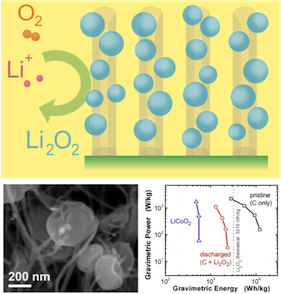Adoption of fully-electric vehicles
will require innovations in battery storage technologies beyond what is
currently achievable with lithium-ion chemistries. Li-O2 batteries are currently being
investigated as an alternative to lithium-ion systems because they are
projected to achieve ~5 times higher gravimetric energy density in the fully
discharged state and ~3 times higher gravimetric energy density in packaged
cells.
MIT MRSEC reseachers have developed binder-free,
aligned carbon nanofiber electrodes, which provide enhanced
gravimetric energy densities in Li-O2
cells. These electrodes have tremendous void volume (>90%), which serves to
accommodate the formation and dissolution of Li2O2 during discharge and charge.
Further, the unique structure of these electrodes enables facile ex situ SEM
studies of the morphology of the deposited Li2O2, enabling insights into electrode
structure optimization.

Carbon nanofiber electrodes enable a 4-fold
improvement in gravimetric energy over state-of-the-art lithium-ion electrodes
at comparable gravimetric powers, while enabling facile imaging of the Li2O2
discharge product.
This
work was supported primarily by the MRSEC Program of the National Science
Foundation under award number DMR-0819762.